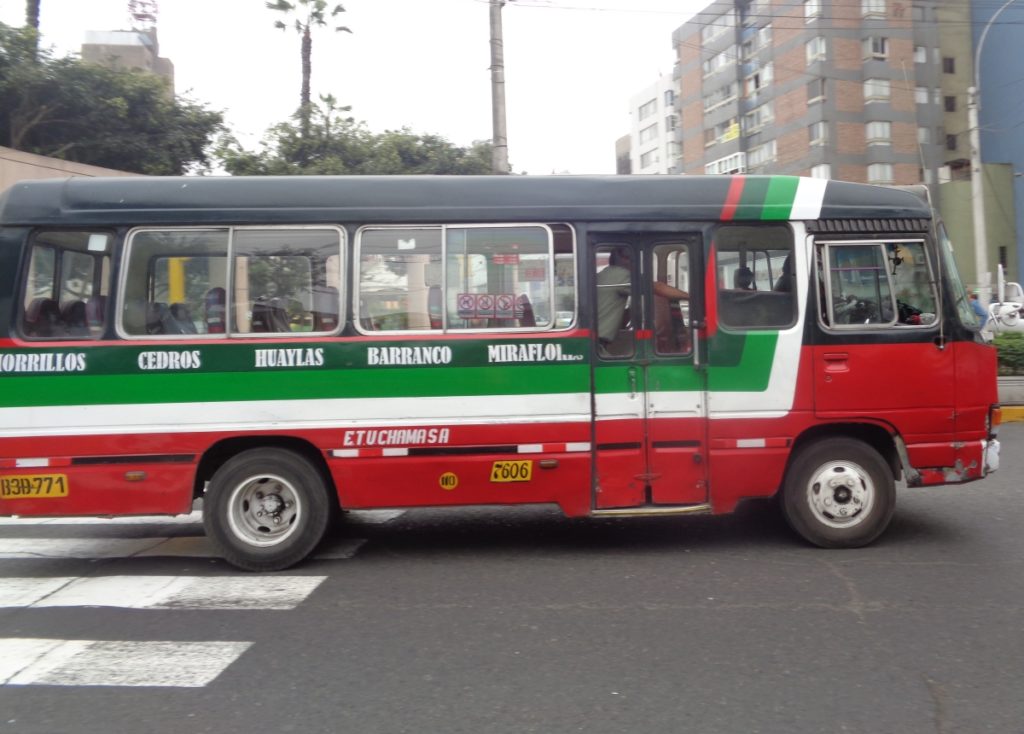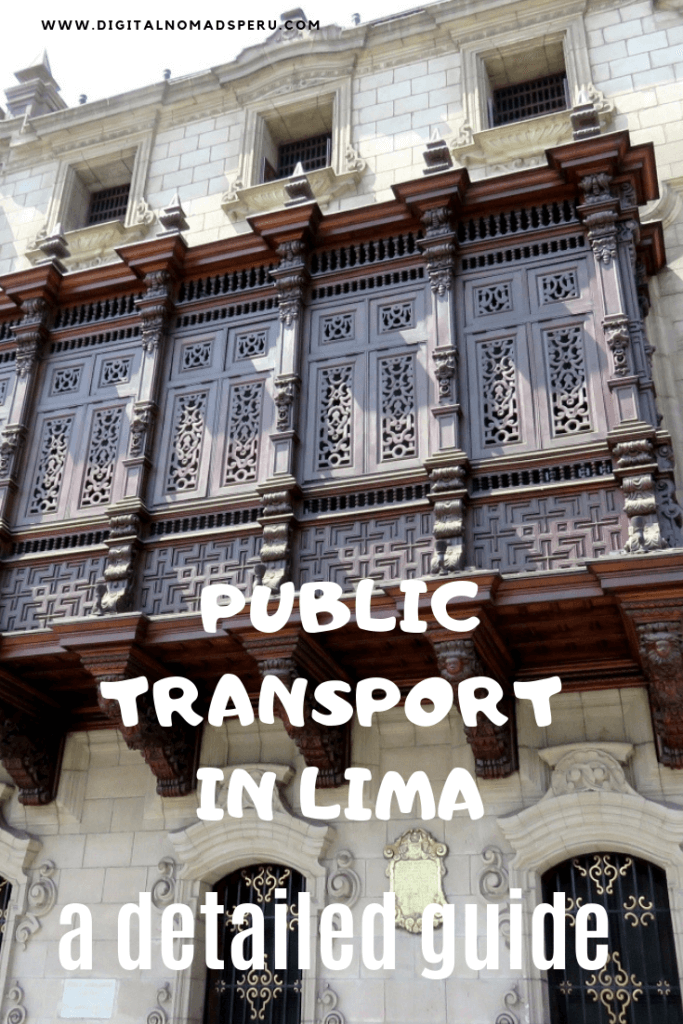With about 10 million people living in the metropolitan region of Lima, it’s one of the biggest cities in Latin America and unfortunately, it’s also one of most chaotic ones as far as traffic is concerned. So why is public transport in Lima so chaotic? Mainly because there’s no underground and everything else is simply not very organized. So are you ready for an urban adventure? Here comes all you need to know about public transport in Lima.
No, stop, first you have to make it from your airport to your accommodation. Until a couple of years ago, Lima airport transfer meant taking a taxi for most people. In 2017, the Airport Express Lima started to operate between the Jorge Chavez Airport in Callao and the neighbourhood of Miraflores where most tourists choose to stay.
This post contains affiliate links, which help to maintain Digital Nomads Peru. Making a purchase by using any of these links doesn’t result in any additional costs for you, of course. Digital Nomads Peru is a participant in the Amazon Services LLC Associates Program, an affiliate advertising program designed to provide a means for sites to earn advertising fees by advertising and linking to Amazon.com. I only recommend goods and services I believe are useful and reliable.
Lima airport by bus or taxi
Lima’s international airport Jorge Chavez is situated in Callao. Unfortunately, Callao doesn’t have a good reputation so please don’t venture out of the airport with all your belongings in general and even less so when you arrive in the evening.
By Airport Express Lima
Is your accommodation in Miraflores? Great! In this case, you can take the Airport Express Lima. It’s a blue bus with functioning wifi which stops at various locations in Miraflores. A one-way ticket costs US$8 or 25 Soles.
If your accommodation is in Barranco, get off at LarcoMar. There’ll be taxis waiting, the ride to Barranco will cost you 6 – 8 soles. Negotiate the price before you get into the taxi.
You can buy your ticket online, at the airport or on the bus. The Airport Express Lima counter is on the left side before you leave the passengers-only area after an international flight.
Once you’ve left that area, you’ll have to make your way through all those taxi drivers who will try to sell you their services. Head to the exit, turn right, cross the street and head slightly right again. You will either see the blue bus from a distance or there’s a sign which marks the bus stop.
The bus currently runs once an hour and there’s normally one waiting at the airport, so you can comfortably wait on the bus and get some work done.
By local buses
There are certainly local buses, too which connect Lima’s various neighbourhoods with the airport. However, unless you’re on an extreme budget, I don’t recommend it. Depending on where your accommodation in Lima is, you may have to change buses at least once and if you don’t know the area, it may not be a good idea to stand around somewhere with all your belongings looking lost. Apart from that, the buses are often very crowded. Depending on how often you need to change the bus, it will cost you about 6 – 8 Soles from the airport to Miraflores. But once again: I don’t recommend it!
By taxi
If you have a lot of luggage or if your accommodation is not in Miraflores or if you’re not travelling alone, taking a taxi is a better option. Once you’ve passed customs, you’ll see several booths where you can book a taxi. Or you reserve your taxi already before your flight with Taxi Dilan. It’s the company we’re using for the Airbnb I’m co-hosting in Barranco and which I use myself, too. Contact them by sending a WhatsApp message to +51 987 254 163 and one of the drivers will be waiting for you. They’re very punctual and reliable and charge 50 Soles from the airport to Miraflores or Barranco.

Public transport in Lima
Buses in Lima
Getting around in Lima by bus can be intimidating when you come from a Western country but it can also be fun. buses are the most chaotic but also the cheapest means of transport. Most of them are privately owned and take you everywhere but the routes are not always clear. However, it’s normally written on the buses which streets they will pass and the driver’s assistant also shouts it out at every stop.
There are normal buses (well, more or less normal as they are usually quite old and often not well maintained) and so-called micros. If possible, take a normal bus as the micros sometimes wait for enough passengers before they move on. I also find it a bit harder to get off a crowded micro as there’s just one door. If you’re stuck and need to get off, shout “Baja”, then the driver will hopefully stop.
A bus ride shouldn’t cost you more than 3 soles and that’s a long ride. I often take the bus from Barranco to Miraflores and that costs 1 sol. It’s best when you have coins with you and always insist on being given the little ticket – as a receipt but also for insurance purposes.
Expect bus drivers in Lima to drive as if they were on the quest to committing suicide. They won’t give you much time to get off, either. There are not always bus stops, so shouting “baja” when you see that your destination is close, is sometimes the best way to get off the bus. On the upside, they will often allow you to get off between official stops (paraderos).
Use Moovit to find out how to get somewhere and how long it will more or less take and follow along on GoogleMaps when you’re on the way to an unknown destination.
Good luck with exploring Lima by bus. Enjoy your ride but avoid buses between 8 and 10 am and between 6 and 8 pm as they’ll be extremely crowded and you’ll be squeezed among dozens of people.
Metropolitano
Metropolitano is a rapid bus system which crosses Lima from the south to the north and vice-versa. It’s your best bet if you live more or less close to one of the stops. The closest stop to Parque Kennedy in Miraflores is Ricardo Palma. Metropolitano will take you to the Historic City Centre. Get off at Jirón de la Unión and walk about 5 minutes to Plaza de Armas, the main square.
Metropolitano has express buses which don’t stop everywhere, so make sure you hop on the right bus. Don’t hesitate to ask employees or other passengers when you’re not sure.
Before you can use the Metropolitano buses, you need to purchase a rechargeable card which currently costs 5 Soles. Every journey will cost you 2.5 Soles.
Android App: Metropolitano (tells you about the routes, the times and where you can recharge your card) – nice to have but not absolutely necessary as Metropolitano is pretty easy to use.
Buses with Metropolitano card : In April 2019, the city of Lima started to introduce rechargeable cards for their new buses (they can easily be spotted as they look very modern) and the metropolitano card can also be used on them. I’ve never used such a bus, just saw them but they look good.
Metro Lima
“Hey, you mentioned above that there is no metro!!” Correct and chances are that you will won’t even get close to Metro Lima, also known as the “Tren Eletrico”.
Some 30 years ago, the Peruvian government decided that it was time for Lima to get a metro. They even got started. However, corruption, a new government and other obstacles came around and 20 years later, there was no sign of a metro yet. However, since 2012, Lima has the first half of its first Metro line. 5 more lines are planned, so do your maths and tell me when they might be finished and in operation.
Line 1 connects some of the neighbourhoods east of Miraflores and Barranco with the city centre, so it’s not very likely that you will ever use it. However, I wanted to mention it at least.
Safety
Personally, I’ve never had any issues but people do get robbed or pickpocketed on buses. Make sure to watch your belongings all the time, keep your bags close to your body or use a money belt. This is especially important during rush hour when there are lots of people on the bus. Avoid sitting close to the doors. There have been incidents of people jumping in, grabbing a backpack or bag and immediately jumping out again.
I really hope that nothing bad will happen to you but accidents or illnesses are always possible, so make sure that you’re insured. I use SafetyWing whenever I travel, it’s easy and affordable, check it out.


- Best cities for digital nomads in Peru - March 5, 2020
- Digital nomads and foreign languages - January 22, 2020
- Do I need an onward ticket to enter Peru? - January 4, 2020
Related Posts
- Taxis in Lima
Unless you come to Peru by bus from Ecuador, Bolivia or Chile, your first contact…
- Learn Spanish in Miraflores/Lima
Spanish in Miraflores Today, I'd like to introduce you to Bertha Díaz and her…
- Taxis in Lima
Unless you come to Peru by bus from Ecuador, Bolivia or Chile, your first contact…



Leave a Reply